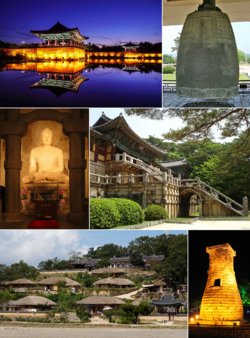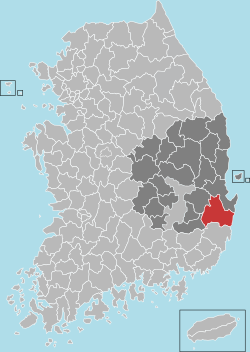 Global Information
Global InformationGyeongju information
Gyeongju
경주시 | |
|---|---|
Municipal City | |
| Korean transcription(s) | |
| • Hangul | 경주시 |
| • Hanja | 慶州市 |
| • Revised Romanization | Gyeongju-si |
| • McCune-Reischauer | Kyŏngju-si |
 Top left: Anapji pond; Top right: Bell of King Seongdeok; middle left: Seokguram; middle right:Bulguksa temple; bottom left: Yangdong Folk Village; bottom right: Cheomseongdae. | |
 Flag  Emblem of Gyeongju | |
 Location in South Korea | |
| Coordinates: 35°51′N 129°13′E / 35.850°N 129.217°E | |
| Country | |
| Region | North Gyeongsang Province |
| Administrative divisions | 4 eup, 8 myeon, 11 dong, 305 ri |
| Government | |
| • mayor | Ju nak Young (주낙영) |
| Area | |
| • Total | 1,324.39 km2 (511.35 sq mi) |
| Population (November, 2022) | |
| • Total | 249,845 |
| • Density | 212/km2 (550/sq mi) |
| • Dialect | Gyeongsang |
| Demonym | Gyeongjuite |
| Time zone | UTC+9 (Korea Standard Time) |
| Area code | +82-54 |
| Website | City of Gyeongju |
Gyeongju (Korean: 경주, pronounced [kjʌ̹ŋ.dʑu]), historically known as Seorabeol (서라벌, pronounced [sʰʌ̹.ɾa̠.bʌɭ]), is a coastal city in the far southeastern corner of North Gyeongsang Province, South Korea.[1][2] It is the second largest city by area in the province after Andong, covering 1,324 km2 (511 sq mi) with a population of 264,091 people as of December 2012[update].[1][3] Gyeongju is 370 km (230 mi) southeast of Seoul,[4] and 55 km (34 mi) east of Daegu.[5] The city borders Cheongdo and Yeongcheon to the west, Ulsan to the south and Pohang to the north, while to the east lies the coast of the Sea of Japan.[1] Numerous low mountains—outliers of the Taebaek range—are scattered around the city.[6]
Gyeongju was the capital of the ancient kingdom of Silla (57 BC – 935 AD), which ruled about two-thirds of the Korean peninsula at its height between the 7th and 9th centuries, for close to one thousand years. Later Silla was a prosperous and wealthy country,[7] and Gyeongju[8] was[when?] the fourth largest city in the world.[9][10][11][12] A vast number of archaeological sites and cultural properties from this period remain in the city. Gyeongju is often referred to as "the museum without walls".[13][14] Among such historical treasures, Seokguram grotto, Bulguksa temple, Gyeongju Historic Areas and Yangdong Folk Village are designated as World Heritage Sites by UNESCO.[15][16] The many major historical sites have helped Gyeongju become one of the most popular tourist destinations in South Korea.[5][17]
The city of Gyeongju was united with the nearby rural Gyeongju County in 1995 and is now an urban–rural complex.[18] It is similar to 53 other small and medium-sized cities with a population under 300,000 people in South Korea.[19] As well as its rich historical heritage, Gyeongju today is affected by the economic, demographic, and social trends that have shaped modern South Korean culture. Tourism remains the major economic driver, but manufacturing activities have developed due to its proximity to major industrial centers such as Ulsan and Pohang. Gyeongju is connected to the nationwide rail and highway networks, which facilitate industrial and tourist traffic.[20][21][22]
- ^ a b c 경주시 [Gyeongju-si] (in Korean). Nate / Encyclopedia of Korean Culture. Archived from the original on 2011-06-10. Retrieved 2009-08-02.
- ^ "S. Korean, US presidents to meet before APEC summit". Xinhua News. 2005-10-18. Archived from the original on 2012-11-02. Retrieved 2009-09-15.
- ^ "Population Gyeongju". Population City. 2015.
- ^ De Ville-Colby, Jacqueline (2018-04-24). The Expatriate Handbook: Seoul, Korea. Hollym. ISBN 9781565910461. Retrieved 2018-04-24.
- ^ a b "Kyŏngju". Encyclopædia Britannica. 2009. Retrieved 2009-09-15.
- ^ 경주시의 자연환경 [Natural environment of Gyeongju] (in Korean). Nate / Encyclopedia of Korean Culture. Archived from the original on 2011-06-10. Retrieved 2009-08-05.
- ^ MacGregor, Neil (2011-10-06). A History of the World in 100 Objects. Penguin UK. ISBN 9780141966830. Retrieved 30 September 2016.
- ^ Chŏng, Yang-mo; Smith, Judith G.; Metropolitan Museum of Art (New York, N.Y.) (1998). Arts of Korea. Metropolitan Museum of Art. p. 230. ISBN 9780870998508. Retrieved 30 September 2016.
- ^ Adams, Edward B. (April 1989). "The Legacy of Kyongju". The Rotarian: 28. Retrieved 23 June 2018.
- ^ Ross, Alan (2013-01-17). After Pusan. Faber & Faber. ISBN 9780571299355. Retrieved 30 September 2016.
- ^ Mason, David A. "Gyeongju, Korea's treasure house". Korea.net. Korean Culture and Information Service. Archived from the original on 3 October 2016. Retrieved 30 September 2016.
- ^ Adams, Edward Ben (1990). Korea's pottery heritage. Seoul International Pub. House. p. 53. ISBN 9788985113069. Retrieved 30 September 2016.
- ^ Robinson et al. 2007. p.187
- ^ "Spring into Korea's Cultural Festivals". Travel Blackboard. 2005-03-04. Retrieved 2009-09-15.
- ^ "Korea, Republic of". UNESCO World Heritage Centre. 2009. Retrieved 2010-08-22.
- ^ "Gyeongju Yangdong Folk Village (UNESCO World Heritage)". Korea Tourism Organization. Archived from the original on 2013-10-23. Retrieved 2010-08-23.
- ^ "Insa-dong Rivals Jeju as Most Popular Tourist Spot". The Chosun Ilbo. 2009-05-05. Retrieved 2009-08-04.
- ^ Lee, Jae Won; Lee, Man Hyung (1997). "Urban-Rural Integration Conflicts After 1994's Reform in Korea" (PDF). Dosi Yeongu, Korea Center for City and Environment Research. 3: 103–121. Archived from the original (PDF) on 2009-09-01. Retrieved 2009-08-31.
- ^ Yun, Daesic; Hwang, Junghoon; Moon, Changkeun (June 2008). "A Study on Analysis of Mode Choice Characteristics and Travel Pattern in Urban-Rural Integrated City" (PDF) (in Korean). Korea Research Institute For Human Settlements. p. 118. Archived from the original (PDF) on 2012-01-05. Retrieved 2009-09-15.
- ^ 경주시의 산업·교통 [Industry and Transportation of Gyeongju] (in Korean). Nate / Encyclopedia of Korean Culture. Archived from the original on 2011-06-10. Retrieved 2009-09-15.
- ^ 경주시 산업과 교통 [Industry and transport of Gyeongju] (in Korean). Nate / Britannica. Archived from the original on 2011-06-10. Retrieved 2009-08-07.
- ^ Tamásy & Taylor, (2008) p.129